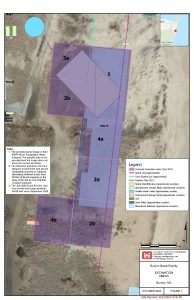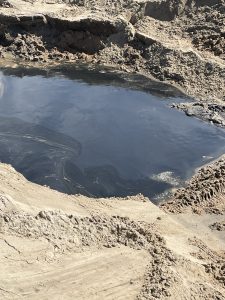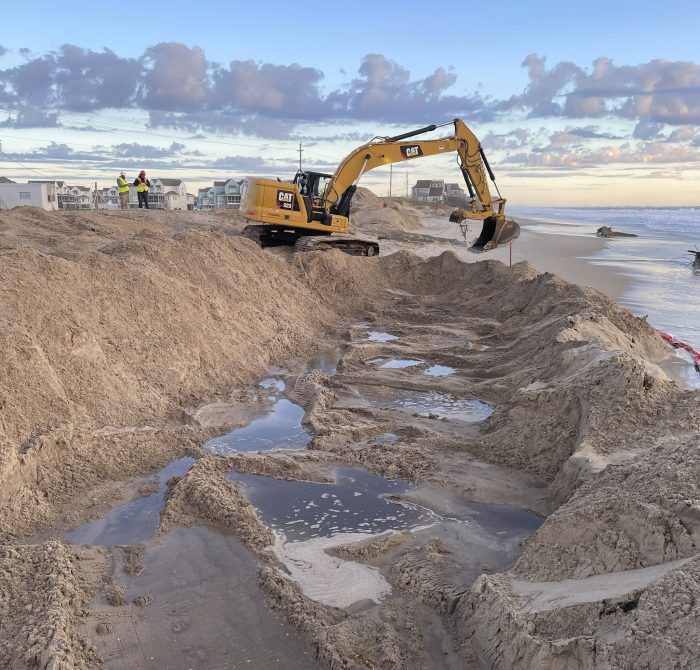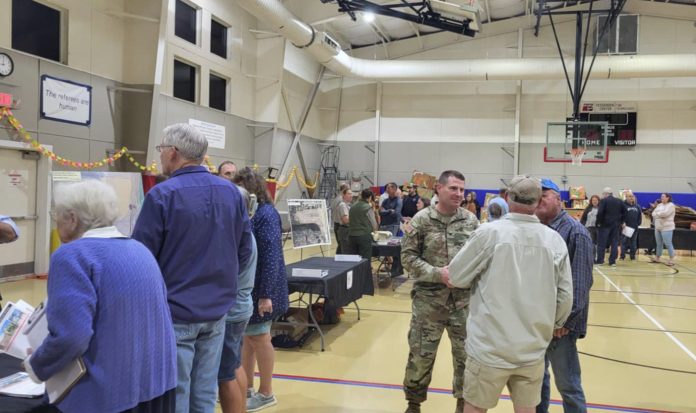
The U.S. Army Corps of Engineers (USACE) hosted a public meeting on Nov. 4 to cover the ongoing remediation efforts at Buxton Beach, and to shed light on two options for the community to stay informed and involved in the process: public meetings or the formation of a Restoration Advisory Board (RAB).
Public meetings versus RAB
The open house-style forum was held in conjunction with federal and state agencies that all have a stake in the ongoing issues, and was the first step towards the formation of a Restoration Advisory Board (RAB) – an endeavor that has been championed by the Buxton Civic Association (BCA) since it was formed in April 2024.
According to a Corps’ 1998 Procedures Manual, as well as a 2007 Handbook from the U.S. Secretary of Defense, the purpose of a RAB is to create a line of communication between local communities and the agencies responsible for cleaning up sites that were previously used by the Department of Defense (DoD).
As outlined by the USACE at Monday’s meeting, RABs require much more time from board members, have a strict agenda, and have a more formal meeting setting, while public meetings do not require as much effort for the local community. Both styles of meetings are open to the public, but RAB members generally represent the community’s voice when it comes to Formerly Used Defense Sites (FUDS) like Buxton Beach.

The RAB is not a decision-making body. However, many stakeholders – including BCA board members – believe that a RAB may provide a clearer path to provide input and influence on future initiatives at Buxton Beach.
“I think it would be a great idea,” said Bill Hunneke, Superfund Section Chief at the NC Department of Environmental Quality (NCDEQ). “Camp Lejeune, for instance, has a great RAB and they’ve been meeting for around 20 years… They all take the RAB members, or anybody who shows up for the meetings, on bus trips through the base, and show them exactly what’s going on at the site.
“I think it would benefit the community because they would have a seat at the table. It carries a little more gravity [than public meetings] – You’re not the decision maker, but you’ve got that seat at the table.”
If a RAB was formed, Dare County, NCDEQ, and the National Park Service would likely all have representation, as well as the USACE and possibly the Coast Guard, alongside Hatteras Island residents.
“We’re in favor of it. I think that it demands accountability, at least in the short term when it’s still really needed,” said BCA board member Heather Jennette. “I like the idea about the public meetings, but I think it’s just far too easy for certain parties or stakeholders to decide that the timing is not convenient, or maybe they don’t feel like they have anything to share at the moment, and get into this cycle of skipping.”
“It makes us more than just public comments – It makes us a stakeholder,” added BCA board member Brian Harris. “It makes it so that we have a voice.”
“We certainly support the concept of a RAB and would be happy to be a partner,” said Sheila Davies, Director of Dare County Health and Human Services. “I do think there’s some added credibility [with a RAB], but that being said, I don’t think you can underestimate the power of what an engaged citizenry, like what you guys have done, can accomplish.”
The USACE is conducting a public survey to gauge the Hatteras Island community’s interest in both a RAB and future public meetings. Click here to take the survey.
Since 1994, hundreds of RABs have been established at military sites and properties across the United States. To learn more about the RAB process and timeline, see the official Handbook from the U.S. Secretary of Defense.
Progress at Buxton Beach and what’s next
Another cornerstone of Monday’s meeting was to provide an update on the ongoing remediation efforts to remove petroleum-contaminated soils at Buxton Beach.
A small section of Buxton Beach at the end of Old Lighthouse Road has been closed to the public for over a year after two offshore hurricanes eroded the shoreline in September 2023 and revealed leftover infrastructure from a 1956-2010 military base, as well as sporadic but strong petroleum smells.
Because the Buxton Beach site is part of the Formerly Used Defense Site (FUDS) program, the USACE is responsible for addressing the petroleum contaminants related to Navy activity from 1956-1982, while the U.S. Coast Guard is responsible for other potential contaminants from their use of the site from 1985-2010.
The Coast Guard recently completed their year-long CERCLA investigation, releasing the results on Oct. 4, which stated that there were “no actionable levels of contaminants resulting from past Coast Guard operations at the site.” However, this investigation used industrial and not residential standards, which have higher thresholds for contaminants. The National Park Service is reviewing the Coast Guard’s report.
Meanwhile, the USACE announced in September 2024 that they were launching an imminent response action to address the petroleum, which included hiring a contractor to remove contaminated soils in order to mitigate the petroleum release.

The contractor’s excavations began on October 2, and as of November 2, the contractor has removed the following from the designated Buxton Beach area:
- 657 cubic yards of impacted petroleum-contaminated soils
- 12,800 gallons of petroleum-contaminated water
- 138,400 pounds of concrete material
- 1,153 feet of metal and PVC pipe
- 1,088 feet of metallic debris, such as wires and cables.
The project will last for 60 days, according to an October 9 press release from the USACE. During this timeframe, the USACE is focused on seven connected areas along the oceanfront, although this does not mean that the beach will be fully clean – or will reopen – once the project is complete.
“The primary purpose is to remove petroleum-impacted soils that are at risk of being washed out to sea,” said Sara Keisler, Project Manager for the USACE Savannah District. “We understand that there will be petroleum contamination remaining at the site, but we do have future actions [planned.]”
The large amounts of petroleum contamination in the soil and especially the groundwater have led to concerns among several stakeholders connected to the project, but there is no way to know how expansive the issues are until comprehensive sampling begins, with a contract expected to be awarded on November 15.
“We have removed roughly 18,000 gallons of water on the site, because as we start digging down into the soil itself, you start to see water, and some of that water does appear to have petroleum-based products in it. We have taken that water out, and put in a fracking machine to separate it,” said Savannah District Commander, Col. Ron Sturgeon.
“At this point, nothing is really a surprise to us… Although we were surprised at the overall event that occurred in September [2024] that really exposed that petroleum. That’s what led us out here in the first place. It was really that event that was a catalyst for us to get out there on the site to do that interim action.”
Multiple agencies at Monday’s meeting praised the USACE for the current in-depth response but cautioned that this current project wasn’t the end-all solution for Buxton Beach remediation.
“The Corps, to their credit, they’ve really stepped up,” said Hunneke. “I think Col. Sturgeon and Sara [Keisler] have been really taking this seriously, so we feel like things are moving.”

“But we still don’t really know where it all is coming from,” he added. “I was watching [the excavation] hole this afternoon, where three of us could stand on our heads and not be at the top of it, and the more they dig, the more the water comes in with rainbows – petroleum. Digging it up, or digging it all out, is probably not an option. You’re never going to dig it all out.”
There’s hope that the November comprehensive soil and groundwater sampling plan will provide more answers, as it will examine the entire 50-acre site, focusing on areas that have historically had less investigation work and where access (during 2004 removal activities) was limited by buildings, roads, or subsurface infrastructure.
While a contract for the testing will be rewarded around November 15, results may not be available until sometime in 2025, according to an update at the September 3 Board of Commissioners meeting.
- For more information from the USACE, visit their Buxton Naval Facility FUDS website.
- For more information from the Cape Hatteras National Seashore, visit their Buxton Beach Access website
- Developing info from the Buxton Civic Association (BCA) can also be accessed via the organization’s website at BuxtonCivic.com or through the BCA’s official Facebook page.










